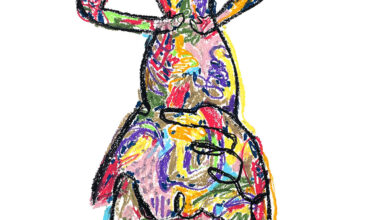A recently opened exhibition at Venice’s Palazzo Mocenigo looks at the influence Russian émigrés in fashion and style.
Text by Anna Battista
The residence from the 17th century of the San Stae branch of the Mocenigo family, one of the most important amongst the Venetian nobility, Palazzo Mocenigo hosts the Museum and Study Centre of the History of Fabrics and Costumes, a must-see in Venice for every passionate fan of the history of fashion. Yet fashion and textile fans will find also a another gem at the Palazzo, the recently opened exhibition “L”eleganza in esilio – Tra moda e costume, il tempo di Diaghilev” (Elegance in Exile – Between Fashion and Costume, Diaghilev”s Time) that examines through roughly 200 dresses, costumes, accessories, sketches and photographs, a very important period of time, the early 1900s and the influence of Russian émigrés in fashion.

Most of the pieces on display come from the collection of fashion and costume historian and collector Alexandre Vassiliev, with some pieces from the archives of Italian dancer and choreographer Toni Candeloro, who owns the largest collection in Italy of costumes and memorabilia linked with ballet and dance. Curated by Francesca Dalla Bernardina and featuring some pieces from Vassiliev”s collection already exhibited two years ago in Tokyo at the Tama Art University Museum, the exhibition opens in the Portego of the Palazzo, that is the large hall on the first floor, with a selection of evening dresses in delicate shades of pink, green and champagne (art historians will definitely take notes about fashion and Fauvism upon arriving in this room…) and some wonderful cloaks and coats in soft velvets.
The details of the evening dresses are particularly beatiful: some of them display connections with Paul Poiret”s designs in their shapes and silhouettes, while all of them feature elements connected with the Orientalist trend so popular in the early decades of the 1900s in Paris. Some of these dresses are for example covered in tiny glass beads or pearls, other feature fringes of beads, elements that also link the designs to Venice. Many women in the late 1800s and early 1900s worked in Venice as “impiraresse” (literally, workers who threaded beads) for the local “conterie” (factories producing glass beads).
The impiraresse from the Cannaregio area in Venice were specialised in making beaded flowers and fringes; the ones from the Castello mainly threaded instead thin and long beads.
As you move to the other rooms of the Palazzo you discover that the curator opted for a sort of colour-coded approach to the displays: the Red Salon also known as the richest and most magnificent room in the Palazzo with its ceiling fresco of “The Apotheosis of the Mocenigo Family” by Jacopo Guarana and with chandeliers by master glass-maker Giuseppe Briati, the sumptuous Green Salon with Guarana”s delicate ceiling fresco entitled “An Allegory of Marriage”, and the Pink Room with paintings by Francesco Pavona, are indeed used as the perfect settings for groups of red, green and pink/violet designs and accessories. Ethereal ivory gowns in lace and tulle covered in intricate embroideries are instead exhibited in the bedroom and the bathroom. The Four Season Salon is the last one dedicated to fashion with stylish dresses in dark shades and white coats featuring dome-shaped beaded embroideries that perfectly match with the fine 1787 grisaille works above the doors by Giambattista Canal.
All the designs in these rooms can be dated between 1913 and 1929 and, while there are among them quite beautiful dresses that you can imagine Eleonora Duse wearing and pieces borrowed from the wardrobe of Russian soprano Félia Litvinne, the best thing about all these creations in a wide range of fabrics (muslin, lame, crêpe de chine, chiffon, satin, silk, brocade and lace, just to mention a few) is that they allow passionate fashion fans and historians to rediscover Haute Couture houses such as Worth, Fortuny, Jenny, Ferreira, Audrey & Denise, Paul Poiret, Callot Soeurs, Grabowsky, Germaine Lecomte, Lanvin and Abziary. The final two rooms – that is the dining room and the library of Count Alvise Nicolò – are mainly dedicated to Toni Candeloro”s collection with Ballets Russes costumes by Léon Bakst, Natalia Gončarova, André Derain and Alexander Benois.
The pieces included in Candeloro”s collection – from “Thamar””s cape for a male figure to costumes from “Le Chant du Rossignol” and sketches for “Le Coq d’Or” – were in some cases given to him by the last generation of Ballets Russes dancers, but there are hundreds of rare memorabilia from other ballets and dancers (including accessories, parts of costumes and ballet shoes) that are equally inspiring.
If at the end of your tour you still have some spare time, just have a break and spend the rest of your visit reading in the library that is specialised in textiles and costumes and also has an entire cabinet of fashion prints and drawings. Chances are you will discover there further inspiring information about fashion, costumes and style.
“L”eleganza in esilio – Tra moda e costume, il tempo di Diaghilev” is at Palazzo Mocenigo, Centro Studi di Storia del Tessuto e del Costume, Venice, Italy, until 6th January 2012.
Special thanks to Monica Giani at the Palazzo Mocenigo ticket office for facilitating my visit to the Museum and Study Centre of the History of Fabrics and Costumes.













